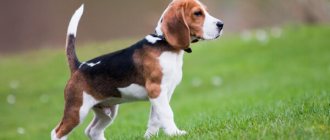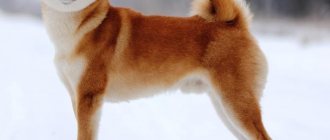If your Doberman puppy is not gaining weight
The current weight gain standard for Doberman Pinschers is the same for all dogs of this breed. As the puppy develops, it should gain weight proportionately. If the pet deviates from the set rate of weight gain, the owner should pay attention to this and monitor the dog’s behavior.
Abnormalities in weight gain can be a sign of certain diseases, but not always. Active animals that love to run and whose owners spend a lot of time walking with them gain weight more slowly.
Climate also affects this indicator. It is necessary to ensure that the puppy receives enough calcium from its diet. Infectious and viral diseases can prevent weight gain. The presence of worms is always the reason for slow weight gain.
Description of the breed
The history of Doberman breeding begins at the end of the 19th century. Despite the fact that the breed was bred recently, its creation is shrouded in a fog of mysteries and secrets . This is due to the fact that the author did not leave any notes about the selection process. Therefore, his followers could only guess in the features of the Doberman his ancient ancestors.
Friedrich Louis Doberman is the creator of this unusual breed. He lived in Germany, worked as a tax collector during the day and as a policeman at night. As you can imagine, not everyone wanted to pay taxes, and Mr. Dauberman had to think about how to make his work as efficient as possible and protect himself from conflict situations with aggressive debtors, because he always carried large sums of money with him.
Already in the 1870s. Dogs that Mr. Dobermann called Thuringian Pinschers . They gained wide popularity among residents of the city of Apolda, and then beyond its borders. They were purchased to assist police officers, as watchmen and bodyguards.
Word of the fearless and loyal Thuringian Pinscher spread at the speed of light thanks to the fact that Mr. Dobermann's dogs actually brought great practical benefits . They could engage in various types of activities, had super-fast reactions and lightning speed, were hardy and not picky in terms of care.
Height and weight of a Doberman puppy by month
The table of height and weight of a Doberman from 1 month of life to a year shows that during this time the size of the dog reaches its maximum. The Doberman's weight increases over the months at such a rate that after a year it is already 10 times more than in the first month. This, of course, depends on a properly balanced diet, which you can also read about on the Give a Paw website.
| Puppy age | Puppy weight (male/female) | Puppy height (male/female) |
| 1 month | 3.8/3.5 kg | 27/22 cm (height at withers) |
| 2 months | 8.7/7.8 kg | 40/33 cm |
| 3 months | 14/12.3 kg | 49/43 cm |
| 4 months | 18.5/16.5 kg | 56/50 cm |
| 5 months | 22.5/20.3 kg | 60/55 cm |
| 6 months | 26/23 kg | 64/58 cm |
| 7 months | 27.8/24.5 kg | 66/60 cm |
| 8 months | 29.5/25.6 kg | 68/62 cm |
| 9 months | 31.2/26.6 kg | 69/64 cm |
| 10 months | 33/27.5 kg | 70/65 cm |
| 11 months | 34/28 kg | 71/65 cm |
| 12 months | 35/29 kg | 72/65 cm |
If at any of the presented ages the pet does not correspond to the specified proportions, then you need to contact a specialist. If the dog is underweight, it is necessary to introduce additional nutritious food into the dog’s diet; if it is overweight, on the contrary, transfer your pet to dietary food. All indicators must be monitored very carefully. A breed like the Doberman needs very close attention from a very young age.
Interesting and useful information about the breed
" comes from the name of its creator, Friedrich Louis Dobermann, who was neither a breeder nor a dog handler, but served in the police and came to the conclusion that he needed a faithful assistant. Unable to find a suitable candidate, he took matters into his own hands and, by crossing Old German Pinschers with other breeds, created dogs of one type, which quickly became popular due to their qualities - intelligence, speed, endurance and fearlessness.
.
Later, Otto Geller took over them and managed to soften their character and endow them with qualities that are now known: modern representatives of the breed, with the right approach, remained loyal, but friendly, obedient guards and attached to the owner and family.
Complementary feeding can be started as early as the 3rd week or earlier, if there is enough breast milk - a little later.
A sufficient amount is characterized by calm behavior of puppies and weight gain, which otherwise slows down.
IMPORTANT!
It is necessary to introduce complementary foods on time: too early will lead to an untimely reduction in the consumption of mother's milk and a decrease in its production, delay will cause growth retardation.
| age, | Height | Oblique torso, | Girth | Front length | Girth | Length | Length | Weight, |
| 1 | 21–28 | 24–31 | 8–11 | 10–17 | 35–46 | 11–16 | 4–7 | 2,8–5,3 |
| 2 | 32–41 | 36–45 | 9–13 | 17–26 | 44–56 | 15–20 | 5,5–8,5 | 7,5–10,5 |
| 3 | 42–50 | 45–55 | 10,5–13 | 23–31 | 54–63 | 18,5–23 | 6,5–10,5 | 11,5–15,5 |
| 4 | 49–57 | 54–63 | 11,0–13,5 | 27–35 | 59–70 | 21–26 | 8,5–12 | 14,5–21 |
| 5 | 54–61 | 60–67 | 11,5–14 | 30–37 | 64–75 | 23–26 | 9–13 | 20–25,5 |
Table for a puppy by month (with growth)
| 1 month | The weight of a newborn Doberman is from 450 to 650 g. This depends on genetic predisposition, the number of puppies born, and sexual characteristics. Females are generally smaller than males. During the first month of life, a Doberman puppy rapidly gains weight. His daily weight gain can be about 80 grams, after 30 days he will already weigh 3.3 kg. up to 4kg. Its height at the withers can reach 22-28 cm. |
| 2 month | Over the next month, the Doberman doubles its weight, and by the end of the second month this figure will be 8-9 kg. He can already feed himself and on average gains 150 grams per day. |
| 3 month | By 3 months of age, puppies are usually transported to new owners. At this point, the weight is already 12.3 - 14 kg. The height at the withers of Dobermans is from 38 to 44 cm. |
| 4 month | By the fourth month, the process of weight gain slows down. The dog begins to grow upward faster, and the weight can range from 16 to 19 kg. |
| 5 month | Upon reaching the age of five months, the puppy is already considered a teenager, growing mainly in length. His chest muscles begin to develop. During this month, Dobermans weigh from 20 kg. up to 23.5 kg. |
| 6 month | The six-month-old Doberman baby is still actively gaining weight, which ranges from 22 to 24 kg. Height at this moment is from 64 to 69 cm. |
| 7 month | In the seventh month, the Doberman gains muscle mass even more slowly and looks like an adult dog. Its weight is 24-28 kg, and its growth rate also slows down. The height at the withers can be about 74 cm. |
| 8 month | Doberman Pinschers at 8 months of age are still gaining a small amount of weight, although they are already reaching the size of an adult. The weight of the pet varies from 26 to 30 kg. They are slowly increasing their height, which is already 70-75 cm. |
| 10 month | The ten-month-old individual finally reaches its full-size dimensions, namely: weight within the range of 25-31 kg. Its height at the withers is from 70 to 75 cm. |
| 12 month | We are now one year old. Now the Doberman is a fully grown animal that weighs 30-36 kg. Height at the withers is within 80 cm. |
Important!
If the puppy deviates significantly in weight from the table, it is necessary to undergo veterinary diagnostics. At an early age, all genetic or pathological problems can be easily and quickly ruled out.
Features of development
Dobermans are an aggressive breed, so socialization is extremely important in their upbringing, which should be done at the age of 6-10 weeks. If a puppy at this age is deprived of communication, he will grow up aggressive and unsociable.
At 3-4 months old, the little Doberman actively explores the world around him and comes into contact with people and other animals. He may begin to figure out who is boss “in the pack” and will bite his owner during the game. Such moments should not be left unattended, the dog must be punished, only then will he understand that the owner is in charge and needs to be listened to.
At the age of 2-5 months, it is necessary to develop his strengths in the puppy. To do this, you need to set him various tasks and be sure to praise him for completing them. Under no circumstances should you frighten a baby; this can have a detrimental effect on his character and his relationship with his owner.
During the period of 6-8 months, the Doberman becomes independent and may stop obeying. He should be punished for disobedience, otherwise the situation may worsen in the future.
Standards for adult Dobermans
The breed appearance standard for Dobermans was adopted back in 1994. According to him, an adult Doberman is a medium-sized dog. The body weight of a male should not exceed 45 kg, of a female - 35 kg. At the same time, the height of males is 72 cm, and that of females is 68 cm.
These data are approximate. They can fluctuate up or down due to factors such as:
- physical activity of the dog;
- the amount of calcium in her daily diet, which directly affects the dog’s growth and, as a consequence, weight;
- diseases including infectious, viral and infection with worms;
- climatic region in which the animal lives.
Important! Also, the amount of food it consumes directly affects the weight of a Doberman. The more a dog eats inappropriate food, the more extra pounds it gains, and vice versa. The less you eat, the lower your weight.
How to weigh correctly?
- The easiest way is to weigh yourself, and then pick up the dog and weigh yourself again. The difference in weight will be the weight of the pet.
- The second way is to attract attention with a treat, holding it over the scales; as a rule, dogs, when they see food, sit motionless.
- Dynamometric scales (usually these are used to weigh bags of vegetables at the market) - put overalls on the dog, attach a scale to the top and pull until the pet lifts off the ground.
What to do if the indicators are higher or lower?
Factors that influence weight deviation from the norm:
- Nutrition. Review your pet's diet; perhaps due to an imbalance of nutrients, he is gaining weight, or, conversely, is not receiving the required amount of nutrients. General recommendations are as follows: less fatty and fried foods, a small amount of carbohydrates (porridge, vegetables, bread), a minimum amount of sweets and candies, more lean meat and animal by-products.
- Diseases. Some diseases (including hormonal) and allergic reactions cause weight and fluid loss. If your four-legged friend is underweight, pay attention to his health condition, but do not start self-medicating, it is better to consult a veterinarian.
- Genetics. Some individuals are born with a deficiency of mass or a tendency to be overweight. Like people, it is difficult for such animals to shift their weight from a given point. Conclusions about normal or abnormal weight should be made by specialists based on analyzes.
- Region of residence. Depending on climatic conditions, the body will lose or gain weight, because thermoregulation processes depend on body weight. But in the case of weight loss, the amount of hair or its thickness may also decrease.











